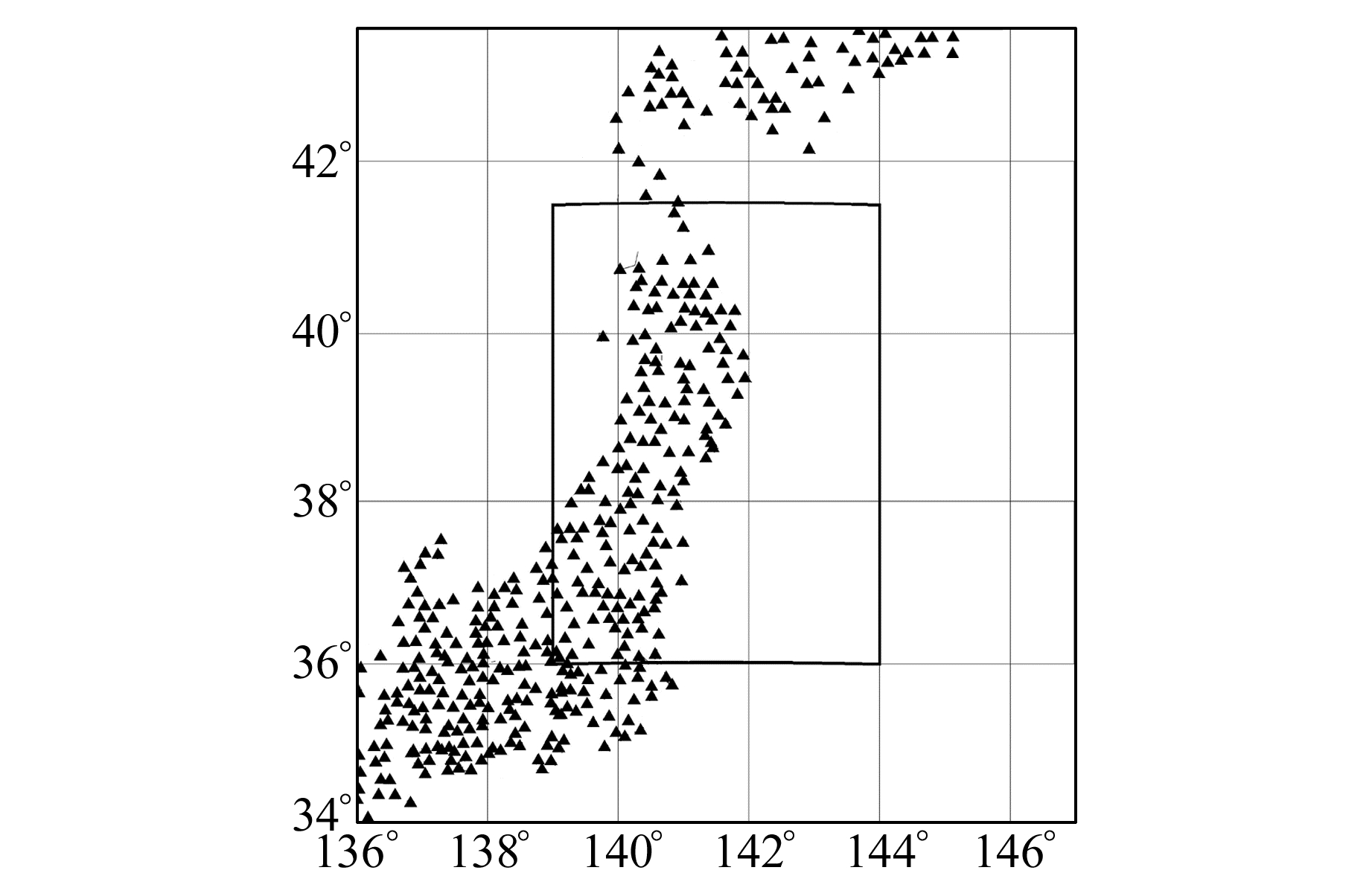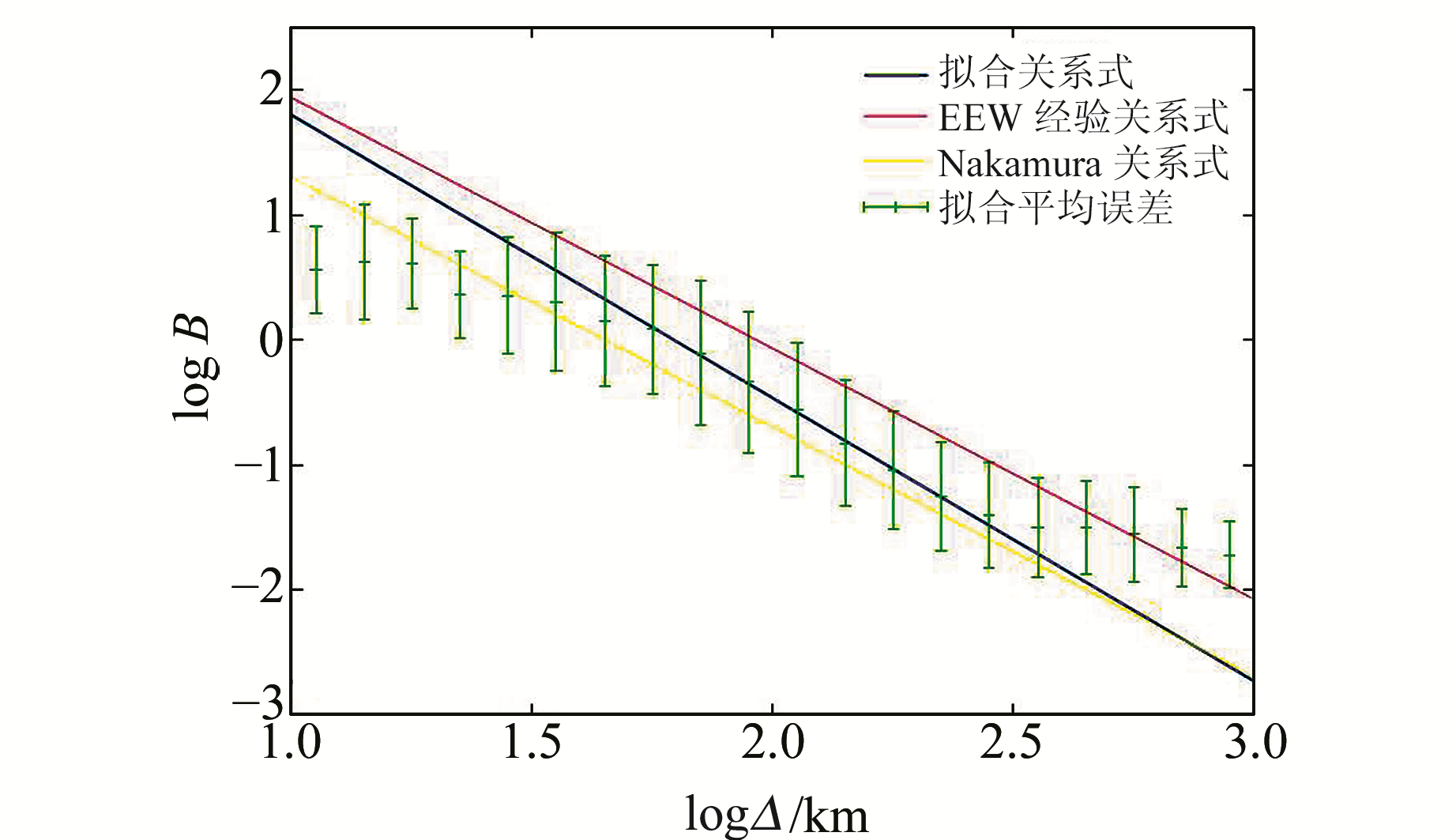2. 武汉地震工程研究院有限公司,武汉市洪山侧路40号, 430071
目前,对地震预警方法[1-8]、理论[9-15]方面的研究已有一定的积累,如B-Δ方法[16]、Tau_c方法等,更是在实际地震预警系统的应用中显示出预警时间短、可靠性高的优势。但对方法中的核心——经验公式及标准值的适用范围、经验参数对震源性质的相关性研究还很缺乏。Nakamura等[17]在2007年用全日本范围内的地震数据拟合了B-Δ方法中使用的经验公式后提出,P波包络线增长率参数可能存在区域差异性,但并未进行深入研究。本文研究了预警方法中经验公式及标准值的区域特征,并对其与其他因素的相关性进行讨论。
1 B-Δ方法B-Δ方法将垂直向P波到后3 s记录取绝对值,然后利用式(1)拟合P波的波形包络线:
| $ f{\rm{ = }}Bt \cdot \exp \left( {-At} \right) $ | (1) |
式中,t为P波到后时间,A、B为拟合的P波包络线表征参数。
提取P波到后2~3 s的绝对值波形序列进行包络计算,应用B-Δ值方法对P波包络线提取表征参数A、B值。
图 1(a)为2012-06-18日本东北地震原始波形(以“A”标注的垂直线表明P波到时),图 1(b)显示了P波到后2 s的振幅绝对值(黑色线)、包络线(红色线)和拟合曲线(蓝色线)。

|
图 1 原始波形记录和P波到后2 s包络线 Fig. 1 An example of a primary earthquake record, its envelope and fitted curve |
B值在本质上即为P波包络线随时间变化的增长率。Odaka等发现,B与震中距Δ的对数存在反比关系,与震级无关。Tsukada等[18]利用日本台网观测数据对该方法进行测试研究,结果也证实,对于4.0级以上的地震,在200 km以内,B与震中距Δ的对数呈反比关系。该关系可表示为:
| $ \log B = a \cdot \log \Delta + c $ | (2) |
式中,a和c是未知系数,由观测到的logB和logΔ决定。该公式可用于地震预警系统由P波到后2~3 s波形记录求解震中距。
B-Δ方法自2003年在日本地震预警系统EEW中被使用以来,取得了较好的效果。部分学者对此方法进行了广泛的应用研究,其中Nakamura等[17]使用全日本的地震数据进行研究后提出,B参数可能存在区域差异特性,建议进行相关的深入研究。
2 研究区域范围及数据来源选取日本KiK-net台网的强震数据进行研究。研究区域为日本东北地区(139°~144°E, 36°~41.5°N),图 2为研究区域的地理位置和KiK-net台网的台站分布。日本东北地区位于两个板块的交汇处,构造变形复杂,强震发生频繁,是地学研究的重要区域之一。本文共收集研究区域内KiK-net台网记录的265个地震事件,19 899条强震数据(表 1)。在2011年日本MS9.0大地震发生后,日本的大部分地震均发生在这片地区及邻近海域。

|
图 2 研究范围(黑色方框)和KiK-net台站分布 Fig. 2 The studied area (the black rectangle) and KiK-net stations |
|
|
表 1 地震数据范围 Tab. 1 The magnitude range, period and region of the events |
震中距40~250 km为可靠的震中距范围。利用公式logB=-2.27·logΔ+4.07计算有效震中距范围内的B和Δ,拟合B-Δ关系的斜率参数a。选取B与Δ相关性较好的震中距范围,计算斜率参数a,可以有效减少因为震中距过近或过远导致地震记录误差过大的影响。
研究发现,a和c值具有依赖性。因此,为保证c值的独立性,使用之前拟合得到的斜率参数a,对所有地震的全部波形记录重新计算经验系数c,得到目标地区的预警经验公式。
对震中距40~250 km范围内的波形数据的Δ和B值统计计算后,得出日本Tohoku地区的B-Δ方法经验公式:
| $ \log \Delta =-0.498 \cdot \log B + 1.965 $ | (3) |
B和Δ的对比关系见图 3。

|
图 3 拟合后的日本东北地区B-Δ拟合关系、经验系数a、c及logB平均误差 Fig. 3 Relation between B-Δ, fitted line with coefficients a, c and errors in logB average |
将此计算结果同日本EEW系统B-Δ公式、Nakamura等[17]统计的B-Δ公式logΔ=-0.5·logB+1.65进行比较(图 4)可以发现,Tohoku地区B-Δ公式拟合线和Nakamura等统计的B-Δ公式拟合线更接近,尤其是在logΔ大于2.4的区域,整体误差小于1个标准差。

|
图 4 日本东北地区B-Δ拟合关系式(蓝色线)与JMA的EEW系统关系式(红色线)、Nakamura关系式(黄色线)比较 Fig. 4 Comparison of relation among B-Δ for 265 events(blue line), JMA EEW System (red line), Nakamura method(yellow line) |
为了研究B-Δ方法中经验系数c的区域特征,将式(2)中的a值设定为-2.27,对全部地震的所有数据进行统计,对每个地震对应的经验公式进行拟合,得到每个地震的经验系数c值,研究目标区域特征及其与其他地震参数的相关性。图 5为经验系数c的分布。

|
图 5 经验系数c的分布 Fig. 5 Histogram of coefficients c |
根据c值大小,将地震事件按[3.1, 3.6)、[3.6, 4.5)和[4.5, 5.0]分成3组进行空间分布投影,结果见图 6。可以看出,该地区记录到的地震波P波包络线增长率似乎存在一定的深度依赖性:深度较小的地震得到较小的c值,即表现出较为平缓的P波包络线增长率;深度较大的地震得到较大的c值,即表现出较为陡峭的P波包络线增长率。

|
图 6 经验系数c在36°~38°N和38°~41.5°N两个分区的空间投影分布 Fig. 6 Distribution of coefficients c and depth projections of three groups and two respective longitude-depth projection |
本文选取的B-Δ方法在日本地震预警系统(EEW)中用来求解地震震中距和震级,取得了较好的效果。B-Δ方法定位速度快,在P波到达4~6 s即可单台求解出地震参数。基于B-Δ方法,本文对日本Tohoku地区的265个地震的19 899条地震记录进行分析研究,在得到拟合的经验公式后,将其同日本EEW系统B-Δ公式、Nakamura等统计的B-Δ公式进行比较,整体误差小于一个标准差。为减小斜率参数a和经验参数c的相关性影响,将a值设定为-2.27,重新计算经验参数c值进行区域特征研究。结果表明,该地区记录到的地震波P波包络线增长率存在深度依赖性:深度较小的地震得到较小的c值,即表现出较为平缓的P波包络线增长率;深度较大的地震得到较大的c值,即表现出较为陡峭的P波包络线增长率。
| [1] |
Wu Y M, Kanamori H. Rapid Assessment of Damage Potential of Earthquake in Taiwan from the Beginning of P Waves[J]. Bull Seism Soc Am, 2005, 95(3): 1181-1185 DOI:10.1785/0120040193
(  0) 0) |
| [2] |
Colombelli S, Amoroso O, Zollo A, et al. Test of a Threshold-Based Earthquake Early-Warning Method Using Japanese Data[J]. Bull Seism Soc Am, 2012, 102(3): 1266-1275
(  0) 0) |
| [3] |
Nakamura Y. On the Urgent Earthquake Detection and Alarm System (UrEDAS)[C]. 9th World Conf Earthquake Engineering, Tokyo-Kyoto, 1988
(  0) 0) |
| [4] |
Allen R M, Kanamori H. The Potential for Earthquake Early Warning in Southern California[J]. Science, 2003, 300(5620): 786-789 DOI:10.1126/science.1080912
(  0) 0) |
| [5] |
Kanamori H. Real-Time Seismology and Earthquake Damage Mitigation[J]. Annu Rev Earth Planet Sci, 2005, 33: 195-214 DOI:10.1146/annurev.earth.33.092203.122626
(  0) 0) |
| [6] |
Igresias A, Singh S K, Ordaz M, et al. The Seismic Alert System for Mexico City: An Evaluation of Its Performance and a Strategy for Its Improvement[J]. Bull Seismo Soc Am, 2007, 97(5): 1718-1729 DOI:10.1785/0120050202
(  0) 0) |
| [7] |
Kamigaichi O. JMA Earthquake Early Warning[J]. Journal of Japan Association for Earthquake Engineering, 2004, 4(3): 134-137 DOI:10.5610/jaee.4.3_134
(  0) 0) |
| [8] |
Kamigaichi O, Saito M, Doi K, et al. Earthquake Early Warning in Japan: Warning the General Public and Future Prospects[J]. Seism Res Lett, 2009, 80(5): 717-726 DOI:10.1785/gssrl.80.5.717
(  0) 0) |
| [9] |
朱福祥, 郭迅, 李山有, 等. 重大工程地震预警初步研究[J]. 世界地震工程, 2002, 18(3): 32-36 (Zhu Fuxiang, Guo Xun, Li Shanyou, et al. Preliminary Study on Earthquake Early Warning System for Significant Infrastructures[J]. World Earthquake Engineering, 2002, 18(3): 32-36)
(  0) 0) |
| [10] |
李山有, 金星, 马强, 等. 地震预警系统与智能应急控制系统研究[J]. 世界地震工程, 2004, 20(4): 21-26 (Li Shanyou, Jin Xing, Ma Qiang, et al. Study on Earthquake Early Warning System and Intelligent Emergency Controlling System[J]. World Earthquake Engineering, 2004, 20(4): 21-26)
(  0) 0) |
| [11] |
马强. 地震预警技术研究及应用[D]. 北京: 中国地震局工程力学研究所, 2008 (Ma Qiang. Study and Application on Earthquake Early Warning [D]. Beijing: Institute of Engineering Mechanics, CEA, 2008) http://cdmd.cnki.com.cn/Article/CDMD-85406-2009057325.htm
(  0) 0) |
| [12] |
金星, 张红才, 李军, 等. 地震预警震级确定方法研究[J]. 地震学报, 2012, 34(5): 593-610 (Jin Xing, Zhang Hongcai, Li Jun, et al. Research on Earthquake Early Warning Magnitude Estimate[J]. Acta Seismological Sinica, 2012, 34(5): 593-610)
(  0) 0) |
| [13] |
张红才, 金星, 李军, 等. 地震预警震级计算方法研究综述[J]. 地球物理学进展, 2012, 27(2): 464-474 (Zhang Hongcai, Jin Xing, Li Jun, et al. Review on Magnitude Estimation Methods Applied to Earthquake Early Warning Systems[J]. Progress in Geophysics, 2012, 27(2): 464-474)
(  0) 0) |
| [14] |
张红才. 地震预警系统关键技术研究[D]. 哈尔滨: 中国地震局工程力学研究所, 2013 (Zhang Hongcai. Study of Key Technologies in Earthquake Early Warning Systems [D]. Harbin: Institute of Engineering Mechanics, CEA, 2013) http://edu.wanfangdata.com.cn/Periodical/Detail/gjdzdt201404013
(  0) 0) |
| [15] |
宋晋东, 李山有. 地震预警中两种利用卓越周期估算震级方法的比较[J]. 地震工程与工程振动, 2012, 32(6): 174-181 (Song Jindong, Li Shanyou. A Comparison between Two Magnitude Estimating Methods Using Predominant Period in Earthquake Early Warning[J]. Journal of Earthquake Engineering and Engineering Vibration, 2012, 32(6): 174-181)
(  0) 0) |
| [16] |
Odaka T, Ashiya K, Tsukada S, et al. A New Method of Quickly Estimating Epicentral Distance and Magnitude from a Single Seismic Record[J]. Bull Seism Soc Am, 2003, 93(1): 526-532 DOI:10.1785/0120020008
(  0) 0) |
| [17] |
Nakamura H, Yamamoto S, Kunugi T, et al. Local Characteristics of the Slope of the Initial Part of the P-Wave Envelope[C]. Seism Soc Japan, Fall Meeting, 2007
(  0) 0) |
| [18] |
Tsukada S, Odaka T, Ashiya K. Analysis of the Envelope Waveform of the Initial Part of P-waves and Its Application to Quickly Estimating the Epicentral Distance and Magnitude[J]. Zisin Journal of the Seismological Society of Japan, 2004, 56(4): 351-361 DOI:10.4294/zisin1948.56.4_351
(  0) 0) |
2. Wuhan Institute of Earthquake Engineering Co Ltd, 40 Hongshance Road, Wuhan 430071, China
 2018, Vol. 38
2018, Vol. 38

